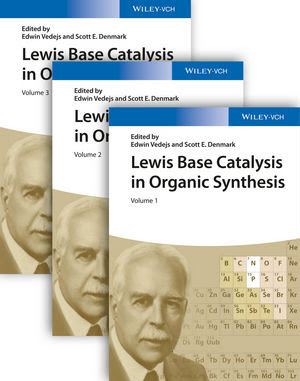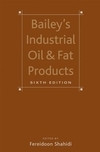Lewis Base Catalysis in Organic Synthesis, by Edwin Vedejs (Editor), Scott E. Denmark (Editor) - 3 Volume Set
Lewis Base Catalysis in Organic Synthesis, 3 Volume Set

Description
This three-volume set represents the first comprehensive coverage of the rapidly expanding field of Lewis base catalysis that has attracted enormous attention in recent years. Lewis base catalysis is a conceptually novel paradigm that encompasses an extremely wide variety of preparatively useful transformations and is particularly effective for enantioselectively constructing new stereogenic centers. As electron-pair donors, Lewis bases can influence the rate and stereochemical course of myriad synthetic organic reactions. The book presents the conceptual/mechanistic principles that underlie Lewis base catalysis, and then builds upon that foundation with a thorough presentation of many different reaction types. And last but not least, the editors, Prof. Edwin Vedejs and Prof. Scott E. Denmark, are without doubt the leaders in this emerging field and have compiled high quality contributions from an impressive collection of international experts.
Table of Contents
Preface for Volumes 1–3 XV
Introduction: Definitions of Catalysis XXI
Volume 1
1 From Catalysis to Lewis Base Catalysis with Highlights from 1806 to 1970 1
Edwin Vedejs
1.1 Introduction 1
1.2 Catalysis 1
1.3 Progress with Catalysis in Organic Chemistry 3
1.4 Ostwald’s Redefinition of Catalysis 5
1.5 The First Example of Lewis Base Catalysis 7
1.6 The Road to Mechanistic Comprehension; Multistage Catalysis by Lewis Base 9
1.7 An Uneven Path to a Unifying Concept 12
1.8 Amine Catalysis 17
1.9 Summary 26
Section I Principles 31
I Principles 31
2 Principles, Definitions, Terminology, and Orbital Analysis of Lewis Base–Lewis Acid Interactions Leading to Catalysis 33
Scott E. Denmark and Gregory L. Beutner
2.1 Introduction 33
2.2 Lewis Definitions of Valence and the Chemical Bond 34
2.3 Extensions, Expansions of, and Objections to the Lewis Definitions 35
2.4 Interpretation of the Lewis Definitions in the Idiom of Molecular Orbital Theory and Quantum Mechanics 38
2.5 Defining Lewis Base Catalysis 40
2.6 Theoretical Analysis of the Geometrical and Electronic Consequences of Lewis Acid–Lewis Base Interactions 44
Consequences of Lewis Acid–Lewis Base Interactions 44
2.7 Summary 51
3 Thermodynamic Treatments of Lewis Basicity 55
Jean-François Gal
3.1 Introduction 55
3.2 Basic Thermodynamics for the Study of Lewis Acid–Base Interactions 56
3.3 Scales of Lewis Affinity and Basicity 58
of Lewis Affinity and Basicity 58
3.4 Lewis Acidity and Lewis Basicity: Thermodynamic Scales 62
3.5 Quantum Chemical Tools 74
3.6 Conclusion and Overview 75
3.7 Summary 76
List of Abbreviations 77
4 Quantitative Treatments of Nucleophilicity and Carbon Lewis Basicity 85
Sami Lakhdar
4.1 Introduction 85
4.2 Nucleophilicity 85
4.3 Lewis Basicity 91
4.4 Nucleofugality 93
4.5 Selected Applications 95
4.6 Conclusion 113
4.7 Summary 113
Section II Mechanism and Lewis Base Catalysis: Nucleophilicity Is Only Part of the Story 119
II Mechanism and Lewis Base Catalysis: Nucleophilicity Is Only Part of the Story 119
5 Anhydride Activation by 4-Dialkylaminopyridines and Analogs 121
Raman Tandon and Hendrik Zipse
5.1 Historical Background 121
5.2 Mechanistic Considerations 121
5.3 Catalyst Structure and Variation 124
5.4 The Influence of Reaction Conditions 130
5.5 The Influence of Acyl Donors 132
5.6 The Influence of Substrate Structure 136
5.7 Summary 141
6 Mechanistic Understanding of Proline Analogs and Related Protic Lewis Bases 145
Alan Armstrong and Paul Dingwall
6.1 Proline Catalysis: Overview 145
6.2 Mechanism of the Proline-Catalyzed Aldol Reaction 147
6.3 Mechanism of the Proline-Catalyzed α-Amination and α-Aminoxylation Reactions 161
6.4 The Proline-Mediated Conjugate Addition Reaction 170
6.5 Modified Proline Derivatives 175
6.6 Concluding Remarks 186
7 Mechanistic Options for the Morita–Baylis–Hillman Reaction 191
Marilia S. Santos, José Tiago M. Correia, Ana Paula L. Batista, Manoel T. Rodrigues Jr., Ataualpa A. C. Braga, Marcos N. Eberlin, and Fernando Coelho
7.1 The Morita–Baylis–Hillman Reaction: An Overview 191
7.2 Kinetic Studies Applied to aza-Morita–Baylis–Hillman Reaction 195
7.3 Theoretical Calculations Applied to MBH Reaction 208
7.4 Mass Spectrometry Aid the Understanding of the Morita–Baylis–Hillman Reaction 217
7.5 Classical and Nonclassical Methods for Mechanistic Studies Associated with the Morita–Baylis–Hillman Reaction: Which Is the Correct Pathway of This Reaction? 226
8 Mechanism of C-Si Bond Cleavage Using Lewis Bases 233
Hans J. Reich
8.1 Introduction 233
8.2 Mechanistic Issues 235
8.3 Alkylation 247
8.4 Benzylation 253
8.5 Allylation 255
8.6 Allenylation/Propargylation 260
8.7 Alkynylation 261
8.8 Arylation 262
8.9 Vinylation 263
8.10 Cyanation 264
8.11 Summary 275
9 Bifunctional Lewis Base Catalysis with Dual Activation of X3Si-Nu and C=)O 281
9.1 Addition of Allyltrichlorosilanes to Aldehydes 281
9.2 Aldol Additions of Trichlorosilyl Enol Ethers Derived from Ketones, Aldehydes, and Esters 293
10 Bifunctional Lewis Base Catalysis with Dual Activation of R–M and C=O 339
10.1 Introduction 339
10.2 Activation of C–Zn and Related C–Mg by a Simple Lewis Base 340
10.3 Lewis Base-Activated C–Zn + C
10.4 Role of Dimeric Organozinc Species 345
10.5 Scope of Carbonyl Substrates in Catalytic Asymmetric Organozinc Addition Reaction 350
10.6 Anionic Lewis Base Activation in Mg(II) and Zn(II) Ate Complexes 372
10.7 Summary 382
11 The Corey–Bakshi–Shibata Reduction: Mechanistic and Synthetic Considerations – Bifunctional Lewis Base Catalysis with Dual Activation 387
Christopher J. Helal and Matthew P. Meyer
11.1 Introduction 387
11.2 The Catalytic Cycle 389
389
11.3 Mechanism 393
11.4 Applications of the CBS Reduction in Organic Synthesis 416
Volume 2
Section III Applications: Lewis Base Catalysis Involving an Activation Step 457
12 Chiral Lewis Base Activation of Acyl and Related Donors in Enantioselective Transformations 459
James I. Murray, Zsofia Heckenast, and Alan C. Spivey
13 Catalytic Generation of Ammonium Enolates and Related Tertiary Amine-Derived Intermediates: Applications, Mechanism, and Stereochemical Models 527
of Ammonium Enolates and Related Tertiary Amine-Derived Intermediates: Applications, Mechanism, and Stereochemical Models 527
Khoi N. Van, Louis C. Morrill, Andrew D. Smith, and Daniel Romo
14 Morita–Baylis–Hillman, Vinylogous Morita–Baylis–Hillman, and Rauhut–Currier Reactions 655
Allison M. Wensley, Nolan T. McDougal, and Scott E. Schaus
15 Beyond the Morita–Baylis–Hilman Reaction 715
Yi Chiao Fan and Ohyun Kwon
16 Iminium Catalysis 805
Aurélie Claraz, Juha H. Siitonen, and Petri M. Pihko
17 Enamine-Mediated Catalysis 857
John J. Murphy, Mattia Silvi, and Paolo Melchiorre
Volume 3
Section IVa Applications: Enhanced Nucleophilicity by Lewis Base Activation 903
IVa Applications: Enhanced Nucleophilicity by Lewis Base Activation 903
18 Si-C-X and Si-C-EWG as Carbanion Equivalents under Lewis Base Activation 905
Ping Fang, Chang-Hua Ding, and Xue-Long Hou
19 Activation of B-B and B-Si Bonds and Synthesis of Organoboron and Organosilicon Compounds through Lewis Base-Catalyzed Transformations 967
Amir H. Hoveyda, Hao Wu, Suttipol Radomkit, Jeannette M. Garcia, Fredrik Haeffner, and Kang-sang Lee
Section IVb Applications: Enhanced Electrophilicity and Dual Activation by Lewis Base Catalysis 1011
20 Lewis Base-Catalyzed Reactions of SiX3-Based Reagents with C
21 Lewis Base-Catalyzed, Lewis Acid-Mediated Reactions 1039
Sergio Rossi and Scott E. Denmark
22 Lewis Bases as Catalysts in the Reduction of Imines and Ketones with Silanes 1077
Pavel Kočovský and Andrei V. Malkov
23 Reactions of Epoxides 1113
Tyler W. Wilson and Scott E. Denmark
Section V Lewis Base-Catalyzed Generation of Electrophilic Intermediates 1153
24 Lewis Base Catalysis: A Platform for Enantioselective Addition to Alkenes Using Group 16 and 17 Lewis Acids 1155
Dipannita Kalyani, David J.-P. Kornfilt, Matthew T. Burk, and Scott E. Denmark
Section VI Bifunctional (and Multifunctional) Catalysis 1213
25 Bifunctional and Synergistic Catalysis: Lewis Acid Catalysis and Lewis Base-Assisted Bond Polarization 1215
Won-jin Chung and Scott E. Denmark
26 Bifunctional Catalysis with Lewis Base and X-H Sites That Facilitate Proton Transfer or Hydrogen Bonding 1259
Curren T. Mbofana and Scott J. Miller
Section VII Carbenes: Lewis Base Catalysis Triggers Multiple Activation Pathways 1289
27 Catalysis with Stable Carbenes 1291
Darrin M. Flanigan, Nicholas A. White, Kevin M. Oberg, and Tomislav Rovis
Summation 1351
Index 1355
Author Information
Edwin Vedejs was born in 1941 in Riga, Latvia. After completion of his BS (University of Michigan, 1962) and PhD (University of Wisconsin, 1966), he spent a postdoctoral year with E. J. Corey at Harvard. Prof. Vedejs then joined the chemistry faculty at the University of Wisconsin (1967). In 1999, he returned to the University of Michigan as the Moses Gomberg Professor of Chemistry. Work in the Vedejs group combines topics at the interface of methodology, total synthesis, heterocycle chemistry, stereochemistry, and related mechanistic studies. Prof. Vedejs has won several awards: Alexander von Humboldt Senior Scientist Award, 1984; Professore a Contratto, University of Bologna, Italy, 1988; Helfaer Professor, 1991-1996 (UW); Pharmacia&Upjohn Teaching Award, 1996 (Chemistry Dept, UW). Robert M. Bock Professor (UW), 1997-98; Paul Walden Medal, Riga Technical University (1997); H. C. Brown Award for Creative Research in Synthetic Methods, 2004 (ACS). Grand Medal of the Latvian Academy of Sciences, 2005. Order of the Three Stars, Latvia, 2006. Honorary Doctorate, Riga Technical University 2010.Related Products
-
Amyloid Proteins The Beta Sheet ...
32,000.00
37,720.00 -
Analysis of Food Toxins and Toxi...
18,900.00
21,479.00 -
Aromatic Hydroxyketones: Prepara...
99,829.00
117,760.00 -
Bailey's Industrial Oil and ...
95,000.00
200,334.00 -
Biopharmaceutical Production Tec...
38,225.00
44,969.00 -
Biotechnology A Multi Volume Com...
48,996.00
59,995.00
- Architecture & Construction Management Books
- Biochemistry, Bioengineering and Biotechnology Books
- Books on Analytical Techniques, GC MS, LC, TLC, HPLC, NMR Spectroscopy
- Books on Water and Wastewater Treatment, Analysis Water Treatment Plants
- Chemical Technology, Organic Chemistry, Chemical Synthesis and Chemical Analysis Books
- Cosmetics Science, Cosmetics Formulations, Manufacture and their Analysis Books
- Drugs and Pharma Science Books
- Essential Oils, their Analysis, Natural Products Extraction, Distillation , Isolates Related Books
- Flavor Science, Flavor Analysis, Flavor Creation, Food Flavors Books
- Food Science and Technology, Baking , Food Ingredients , Food Quality , Food Regulations
- Formulations of Perfumes for Agarbatti, Air Freshners, Soaps & Detergents, Fabric Softeners , French style Perfumes, Attars , OUD, Fine Fragrances
- Fragrances, Scents, Attars , Perfumery and Aroma Chemicals Books
- Herbal, Ayurvedic, Medicinal Plants and Aromatic Plants Books
- Law Books
- Major Reference Works (MRWS) Sets - MultiVolume Sets
- Medical Books
- Medical Journals Wolters Kluwer | Medknow India
- NEW ARRIVALS
- Perfumer's Resources
- Special Indian Reprint !


















